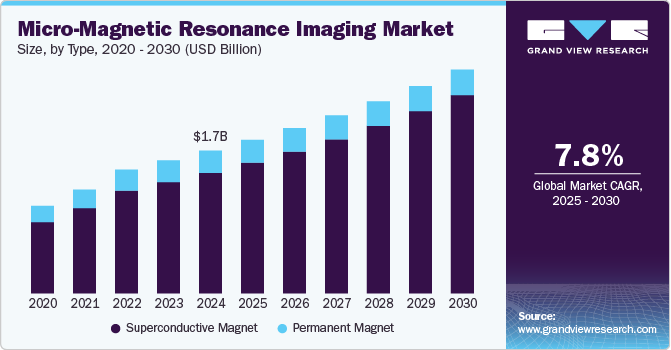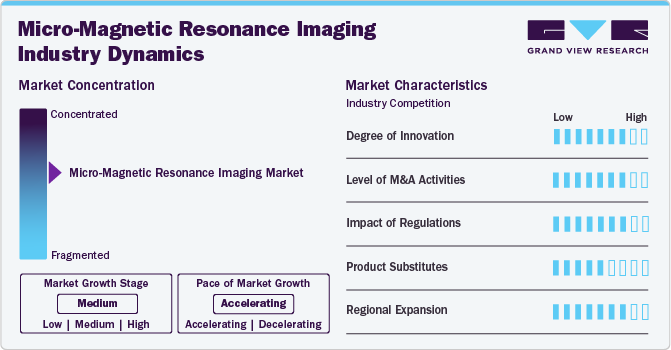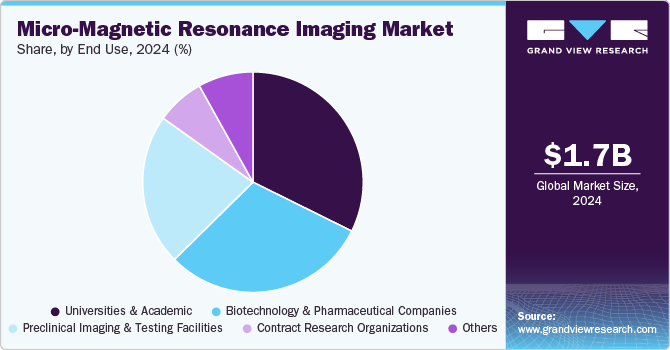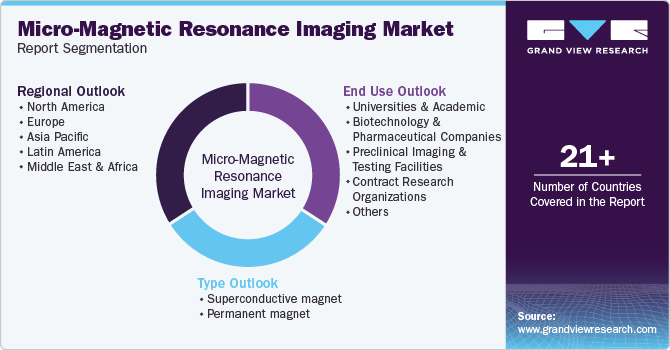
Micro-Magnetic Resonance Imaging Market Size, Share & Trends Analysis Report By Type (Permanent Magnet, Superconductive Magnet), By End Use (Universities And Academic), By Region, And Segment Forecasts, 2025 - 2030
- Report ID: GVR-4-68039-917-9
- Number of Report Pages: 100
- Format: PDF
- Historical Range: 2018 - 2023
- Forecast Period: 2025 - 2030
- Industry: Healthcare
Market Size & Trends
The micro-magnetic resonance imaging market size was estimated at USD 1.72 billion in 2024 and is projected to grow at CAGR of 7.8% from 2025 to 2030. The market is driven by several key factors, such as advancements in imaging technology, increasing clinical and preclinical research applications, and a rising demand for non-invasive diagnostic techniques. The market is expanding rapidly as healthcare providers and researchers increasingly recognize the benefits of micro-MRI in providing high-resolution images at the microstructural level. The rise in preclinical trials utilizing advanced imaging modalities further contributes to the market growth.

Advancements in imaging technology is a primary driver of the micro-magnetic resonance imaging (micro-MRI) market, significantly enhancing its capabilities and applications. For instance, introducing ultra-high-field MRI systems, particularly those operating at 7 Tesla and above, has increased imaging resolution by over 30%, allowing researchers to visualize cellular and sub-cellular structures with unprecedented detail. In addition, improvements in hardware, such as developing novel superconducting materials, have reduced signal noise, increasing sensitivity by approximately 25%. As the Journal of Biomedical Imaging reported, these technological strides have spurred a 20% growth in the adoption of micro-MRI for preclinical studies from 2018 to 2022, showcasing its growing importance in research and clinical diagnostics.
The rise in preclinical trials utilizing advanced imaging modalities is significantly driving the growth of the micro-magnetic resonance imaging market. This trend is bolstered by the increasing complexity of biomedical research, where micro-MRI provides high-resolution, non-invasive imaging crucial for observing biological processes in real time. In addition, a report from the National Institutes of Health highlights that using micro-MRI in preclinical settings has accelerated the development timeline for new therapies by approximately 15%, enabling researchers to gather critical data more efficiently. This heightened adoption underscores the importance of advanced imaging techniques in facilitating innovative research, thereby propelling investment and growth within the micro-MRI market.
Increased investments in biomedical research are significantly propelling the micro-magnetic resonance imaging market, as funding agencies and private sectors recognize the critical role of advanced imaging techniques in developing innovative therapies. For instance, according to the National Institutes of Health, funding for biomedical research has grown by approximately 10% annually over the past five years, with a substantial portion allocated to imaging technologies. This financial support has enabled the advancement of micro-MRI systems, improving resolution and sensitivity that enhance research outcomes.
Market Concentration & Characteristics
The micro-magnetic resonance imaging industry is characterized by moderate concentration and a mix of established multinational companies and emerging players. Major companies dominate, with advanced technology, extensive distribution networks, and substantial R&D investments. These include leaders such as Bruker, Aspect Imaging Ltd., Agilent Technologies Inc., Cubresa Inc., and MR Solutions. The industry features high innovation driven by technological advancements such as advanced micro-magnetic resonance imaging. Emerging players contribute by introducing novel solutions and driving competition. The industry is influenced by regulatory standards and the need for continuous product development to meet evolving clinical demands.
The degree of innovation within the micro-magnetic resonance imaging industry is high, driven by rapid advancements in technology and methodologies that enhance imaging capabilities and applications. Notable innovations include the development of novel contrast agents that improve tissue differentiation, allowing for better visualization of specific cellular components. In addition, breakthroughs in machine learning algorithms are revolutionizing image processing, reducing scan time by up to 50% while enhancing image clarity and diagnostic accuracy. Furthermore, hybrid imaging techniques that combine micro-MRI with other modalities, such as optical imaging or positron emission tomography (PET), are gaining traction, providing comprehensive insights into biological processes.

The level of mergers and acquisitions (M&A) activities in the micro-magnetic resonance imaging industry has been moderate, reflecting the growing interest and competitive dynamics within the sector. In addition, partnerships between biotech firms and imaging technology companies are increasingly common, fostering collaboration to combine expertise and resources. For instance , in October 2021, Cubresa Inc. entered into a licensing agreement with the Sino-Canadian Health Institute for its BrainPET technology. This collaboration aims to enhance the development and commercialization of innovative imaging solutions for brain research and clinical applications. The agreement is expected to leverage Cubresa's expertise in micro-magnetic resonance imaging, promoting advancements in neuroimaging technologies and improving patient care.
The impact of regulations on the micro-magnetic resonance imaging industry is high, as regulatory frameworks ensure the safety, efficacy, and quality of imaging technologies. For instance, the U.S. Food and Drug Administration (FDA) has established stringent guidelines for approving new micro-MRI systems and contrast agents, which can extend development timelines but ultimately enhance patient safety and trust in these technologies. A recent FDA approval of a novel micro-MRI contrast agent highlighted the agency's commitment to evaluating new products based on stringent criteria, ensuring they meet the necessary standards for clinical use. In addition, the European Medicines Agency (EMA) has implemented similar regulations, fostering a competitive industry that prioritizes innovation while safeguarding patient health.
The micro-magnetic resonance imaging industry faces competition from various product substitutes, primarily other imaging modalities such as computed tomography (CT), positron emission tomography (PET), and traditional MRI. For instance, while CT scans provide rapid imaging and are widely used for diagnosing acute conditions, they expose patients to ionizing radiation, which has led to a growing preference for non-invasive techniques such as micro-MRI that avoid such risks. In addition, advancements in optical imaging technologies, such as fluorescence and bioluminescence imaging, are emerging as viable alternatives for certain preclinical applications, offering high-resolution insights into biological processes.
The regional expansion is driven by the increasing demand for micro-MRI in biomedical research and pre-clinical trials. Owing to recent regional expansion by leading players in the industry, it is expected to witness high growth over the forecast period. For instance, in June 2024, Cubresa partnered with The Neuro (Montreal Neurological Institute-Hospital at McGill University), selecting its BrainPET technology for its 7T brain research program. This collaboration marks a notable regional expansion for Cubresa, enhancing its presence in the Canadian industry and emphasizing the value of advanced neuroimaging capabilities.
Type Insights
The superconducting magnets segment dominated the micro-magnetic resonance imaging market, capturing the largest revenue share of 84.4% in 2024. This growth can be attributed to their unique ability to conduct magnetic fields without electrical resistance, enabling the generation of significantly larger electric currents. For instance[NP3] , The BioSpec Maxwell is a high-performance MRI system developed by Bruker BioSpin, designed specifically for preclinical research. It utilizes advanced superconducting magnet technology to achieve high magnetic field strengths, which significantly enhances imaging resolution and sensitivity. This system is particularly well-suited for studying small animal models in fields such as neuroscience, oncology, and cardiovascular research.Its capability to generate high-quality images facilitates the exploration of complex physiological and pathological conditions, making it a valuable tool for advancing biomedical research.
The superconducting magnets segment of the micro-magnetic resonance imaging market is expected to grow exponentially over the forecast period owing to several key factors such as the increasing demand for high-resolution imaging in preclinical and clinical applications is driving the adoption of advanced MRI systems that utilize superconducting technology, such as 7 Tesla and higher. In addition, ongoing technological advancements, including improvements in magnet design and cooling techniques, are making superconducting magnets more accessible and cost-effective for research institutions. The growing emphasis on non-invasive imaging methods in biomedical research further supports this segment's expansion, as superconducting magnets provide the necessary performance to meet evolving research demands.
End Use Insights
The universities and academic institutions segment held the largest market share at 32.4% in 2024, attributed to the growing application of micro-MRI technology in academic research. These institutions are at the forefront of innovation, utilizing micro-MRI for a wide range of studies, including neuroscience, cancer research, and drug development. For instance, leading universities such as Harvard and Stanford have integrated high-field micro-MRI systems into their research programs, enabling detailed exploration of brain function and pathology. The ability to conduct non-invasive imaging at a micro level allows researchers to gather critical data that advances understanding in various scientific fields. In addition, the growing emphasis on interdisciplinary research has led to collaborations between universities and medical institutions, enhancing the demand for micro-MRI technologies in educational settings. This trend underscores the essential role that academic research plays in driving market growth and technological advancements in the micro-MRI landscape.

Preclinical imaging and testing facilities segment is projected to experience the fastest growth of 8.5% over the forecast period. This rapid expansion is attributed to the increasing demand for advanced imaging technologies that facilitate early-stage drug development and biological research. This trend is further amplified by the introduction of cutting-edge micro-MRI systems, such as 7 Tesla MRI, which allow for detailed observation of disease mechanisms and treatment responses in small animal models. With regulatory bodies mandating comprehensive preclinical evaluations, the reliance on micro-MRI technology is expected to grow, pushing researchers to adopt these advanced imaging solutions to meet stringent research standards. This convergence of increased funding, technological advancements, and regulatory requirements not only enhances the capabilities of preclinical imaging but also drives market growth by encouraging wider adoption of micro-MRI in various research applications.
Regional Insights
North America micro-magnetic resonance imaging market dominated the overall global market and accounted for 29.41% of revenue share in 2024. The increasing number of micro-MRI based research studies in the region significantly drives the North American micro-magnetic resonance imaging market. One significant contributor is the region's robust healthcare infrastructure, which includes numerous leading research institutions and universities that heavily invest in advanced imaging technologies. For instance, institutions such as the Mayo Clinic and Johns Hopkins University are at the forefront of medical research, utilizing micro-MRI to enhance understanding of complex diseases such as Alzheimer’s and cancer. In addition, increased funding from organizations such as the National Institutes of Health (NIH) has bolstered research initiatives that leverage micro-MRI, promoting advancements in both clinical and preclinical studies.

U.S. Micro-Magnetic Resonance Imaging Market Trends
The micro-magnetic resonance imaging market in the U.S. held a significant share of North America's micro-magnetic resonance imaging market in 2024. The U.S. market for micro-magnetic resonance imaging is driven by recent collaborations made by the key players in the market. For instance, in September 2021, Cubresa Inc. signed a memorandum of understanding with the University of California, Davis, to collaborate on advanced imaging technologies, particularly neuroimaging. This partnership aims to integrate Cubresa's innovative imaging solutions into UC Davis's research programs. The collaboration highlights the significance of advanced imaging in understanding and treating neurological conditions. This agreement is expected to enhance Cubresa's presence in the U.S. market and contribute to the growth of the micro-magnetic resonance imaging sector.
Europe Micro-Magnetic Resonance Imaging Market Trends
The micro-magnetic resonance imaging market in Europe is experiencing significant growth, driven by increasing investments in biomedical research and advancements in imaging technology. Countries such as Germany and the United Kingdom are leading this growth, with substantial funding allocated to research initiatives. For instance, Germany's Federal Ministry of Education and Research has allocated over USD 1.1 billion for health-related research projects involving advanced imaging techniques such as micro-MRI. In addition, establishing collaborative research networks, such as the European Society for Magnetic Resonance in Medicine and Biology (ESMRMB), promotes knowledge sharing and innovation in imaging technologies. This focus on improving diagnostic accuracy and understanding of complex diseases, combined with a rising number of preclinical studies, underscores the growing importance of micro-MRI in Europe’s healthcare landscape, positioning the region as a key player in the global market.
The UK micro-magnetic resonance imaging market is experiencing exponential growth driven by the rise in preclinical trials utilizing advanced imaging modalities such as micro-MRI. Increasing funding for biomedical research is also driving the market. For instance, the UK Research and Innovation (UKRI) has significantly boosted funding for biomedical research, with investments exceeding Euro 1 billion to enhance preclinical capabilities, including imaging technologies. This funding supports initiatives integrating micro-MRI into research protocols, enabling detailed visualization of biological processes in small animal models.
The micro-magnetic resonance imaging market in France is expected to grow significantly due to a combination of increasing government investment in healthcare research and the rising demand for advanced imaging technologies in both clinical and preclinical settings. For instance, the French government has allocated approximately USD 1.6 billion to the "France 2030" initiative, which promotes innovation in medical technology and enhances research capabilities. This funding is directed towards advancing imaging techniques, including micro-MRI, to improve diagnostics and treatment strategies. Establishing collaborative networks, such as the French Society of Magnetic Resonance in Medicine, also fosters knowledge exchange and innovation in the field. As a result, these factors create a conducive environment for the growth of the micro-MRI market in France, positioning the country as a key player in the European biomedical research landscape.
Germany micro-magnetic resonance imaging market is poised for significant growth, driven by initiatives to foster innovation and enhance the overall capabilities of micro-MRI technology. Germany is home to a robust ecosystem of research institutions and universities that prioritize the development of advanced imaging modalities. For instance, collaborations between institutions such as the Fraunhofer Society and various universities are focused on improving the sensitivity and resolution of micro-MRI systems, enabling more detailed imaging of biological processes. In addition, funding programs such as the “Innovative Medical Technology” initiative support projects integrating cutting-edge technologies into clinical practice, further advancing micro-MRI capabilities.
Asia Pacific Micro-Magnetic Resonance Imaging Market Trends
Asia-Pacific micro-magnetic resonance imaging market is experiencing substantial growth, primarily driven by increasing investments in healthcare infrastructure and a rising focus on advanced medical imaging technologies. Countries such as China and India are significantly enhancing their healthcare capabilities, with China allocating over USD 120 billion towards healthcare reform and innovation, including imaging technology advancements. In addition, establishing research institutes and partnerships with global technology companies fosters the region's development and adoption of micro-MRI systems. Collaborations between academic institutions and biotechnology firms are leading to innovations in imaging techniques, enabling researchers to conduct more sophisticated preclinical studies. As a result, the convergence of increased funding, technological collaboration, and rising healthcare needs drives rapid growth in the micro-MRI market across Asia-Pacific.
The micro-magnetic resonance imaging market in Japan is set for rapid growth due to the rising utilization of micro-magnetic resonance imaging in the country. The micro-magnetic resonance imaging market in Japan is set for rapid growth due to the rising utilization of this advanced imaging technology across various sectors, including medical research and clinical diagnostics. Japan’s strong emphasis on innovation in healthcare is evident in its significant investments in medical technology, with the government allocating around USD 9 billion to healthcare R&D initiatives to enhance diagnostic capabilities. Leading institutions, such as RIKEN and Tokyo Medical University, are increasingly adopting micro-MRI to conduct groundbreaking research in areas such as neuroscience and oncology, enabling them to visualize cellular structures and disease progression with remarkable clarity.
China micro-magnetic resonance imaging market is expanding, primarily driven by technological advancements and a growing emphasis on early disease detection. The country has significantly advanced in developing high-field micro-MRI systems, with innovations that enhance imaging resolution and speed, allowing for more detailed examinations of biological tissues. In addition, the increasing collaboration between leading research institutions and medical device manufacturers is fostering the development of cutting-edge imaging solutions tailored for specific medical applications, such as oncology and neurology. The rising demand for advanced micro-MRI devices in the country further drives the market's growth.
The micro-magnetic resonance imaging market in India is highly competitive and driven by an increasing demand for advanced imaging technologies in clinical and research applications. As the country invests heavily in healthcare infrastructure, with government initiatives aiming to enhance medical facilities and research capabilities, there is a notable rise in the adoption of micro-MRI systems. Leading institutions such as the Indian Institute of Technology and various premier medical colleges are incorporating micro-MRI into their research programs to explore complex biological processes and develop new therapeutic strategies. The combination of government support, increasing research collaborations, and a rising focus on innovative healthcare solutions positions India to make significant progress in medical imaging, which drives the growth of the market in the country.
Latin America Micro-Magnetic Resonance Imaging Market Trends
The Latin American micro-magnetic resonance imaging market is driven by rising healthcare investments and an increasing emphasis on advanced imaging technologies. The region's healthcare expenditure is projected to reach approximately USD 1.5 trillion by 2025, creating opportunities to adopt cutting-edge diagnostic tools such as micro-MRI. In addition, the collaboration between academic institutions and the medical technology industry is fostering innovation in imaging solutions tailored to the specific healthcare challenges faced in the region. As research institutions in the region increasingly incorporate micro-MRI into their studies, particularly in oncology and neurology, the Latin American market is poised to expand significantly, reflecting a broader trend toward innovation in healthcare.
Saudi Arabia Micro-Magnetic Resonance Imaging Market Trends
The micro-magnetic resonance imaging market in Saudi Arabia is experiencing significant growth, fueled by substantial investments in healthcare infrastructure as part of the government’s Vision 2030 initiative, which allocates over USD 40 billion to transform the healthcare sector. This includes establishing modern medical facilities equipped with advanced imaging technologies such as micro-MRI to improve patient outcomes. Leading institutions, such as King Faisal Specialist Hospital and Research Centre, are increasingly utilizing micro-MRI for clinical and research applications, particularly in oncology and neurology, to enhance disease diagnosis and treatment planning. Collaborations between academic institutions and healthcare providers further foster innovative micro-MRI research, positioning Saudi Arabia as an emerging player in the global micro-MRI market and enhancing its capabilities in medical research and healthcare delivery.
Key Micro-Magnetic Resonance Imaging Company Insights
The competitive scenario in the micro-magnetic resonance imaging market is highly competitive, with key players such as Bruker, Aspect Imaging Ltd., Agilent Technologies Inc.,
Cubresa Inc. and MR Solutions. The major companies are undertaking various organic and inorganic strategies such as new product development, collaborations, acquisitions, mergers, and regional expansion to serve the unmet needs of their customers.
Key Micro-Magnetic Resonance Imaging Companies:
The following are the leading companies in the micro-magnetic resonance imaging market. These companies collectively hold the largest market share and dictate industry trends.
- Bruker
- Aspect Imaging Ltd.
- Agilent Technologies Inc.
- Cubresa Inc.
- MR Solutions
Recent Developments
-
In July 2022, MR Solutions opened Turkey's first preclinical imaging facility, equipped with advanced imaging technologies, including a 7T MRI system. This facility aims to enhance research capabilities in various scientific fields, such as neuroscience and oncology.
-
In February 2022, Bruker announced a significant advancement in micro-magnetic resonance imaging (μMRI) by introducing its GHz-class NMR technology, which enhances structural biology research. This cutting-edge technology allows for high-resolution imaging at the molecular level, facilitating detailed studies of biological samples. Integrating this micro-MRI capability is expected to revolutionize research in areas such as drug development and disease understanding by providing unprecedented insights into molecular structures and dynamics.
-
In November 2021, MR Solutions announced the launch of the world’s first cryogen-free 9.4T MRI system, marking a significant breakthrough in magnetic resonance imaging technology. This innovative system eliminates the need for liquid helium, making it more environmentally friendly and easier to operate. It offers high-resolution imaging capabilities, making it particularly suitable for preclinical research applications.
Micro-Magnetic Resonance Imaging Market Report Scope
|
Report Attribute |
Details |
|
Market size value in 2025 |
USD 1.85 billion |
|
Revenue forecast in 2030 |
USD 2.70 billion |
|
Growth rate |
CAGR of 7.8% from 2025 to 2030 |
|
Historical data |
2018 - 2023 |
|
Forecast period |
2025 - 2030 |
|
Quantitative units |
Revenue in USD million and CAGR from 2025 to 2030 |
|
Report coverage |
Revenue forecast, company ranking, competitive landscape, growth factors, and trends |
|
Segments covered |
Type, end use, region |
|
Regional scope |
North America; Europe; Asia Pacific; Latin America; and MEA |
|
Country scope |
U.S.; Canada; Mexico; U.K.; Germany; France; Italy; Spain; Denmark; Sweden; Norway; Japan; China; India; Australia; Thailand; South Korea; Brazil; Argentina; South Africa; Saudi Arabia; UAE; Kuwait. |
|
Key companies profiled |
Bruker; Aspect Imaging Ltd.; Agilent Technologies Inc.; Cubresa Inc.; MR Solutions. |
|
Customization scope |
Free report customization (equivalent up to 8 analysts working days) with purchase. Addition or alteration to country, regional & segment scope. |
|
Pricing and purchase options |
Avail customized purchase options to meet your exact research needs. Explore purchase options |
Global Micro-Magnetic Resonance Imaging Market Report Segmentation
This report forecasts revenue growth at country levels and provides an analysis on the latest industry trends and opportunities in each of the sub-segments from 2018 to 2030. For the purpose of this study, Grand View Research has segmented the micro-magnetic resonance imaging market report on the basis of type, end use, and region:

-
Type Outlook (Revenue, USD Million, 2018 - 2030)
-
Superconductive magnet
-
Permanent magnet
-
-
End Use Outlook (Revenue, USD Million, 2018 - 2030)
-
Universities and academic
-
Biotechnology and pharmaceutical companies
-
Preclinical Imaging and testing facilities
-
Contract research organizations
-
Others
-
-
Region Outlook (Revenue, USD Million, 2018 - 2030)
-
North America
-
U.S.
-
Canada
-
Mexico
-
-
Europe
-
UK
-
Germany
-
France
-
Italy
-
Spain
-
Denmark
-
Sweden
-
Norway
-
-
Asia Pacific
-
Japan
-
China
-
India
-
Australia
-
South Korea
-
Thailand
-
-
Latin America
-
Brazil
-
Argentina
-
-
Middle East & Africa
-
South Africa
-
Saudi Arabia
-
UAE
-
Kuwait
-
-
Frequently Asked Questions About This Report
b. The global micro-magnetic resonance imaging market size was estimated at USD 1.72 billion in 2024 and is expected to reach USD 1.85 billion in 2025.
b. The global micro-magnetic resonance imaging market is expected to grow at a compound annual growth rate of 7.8% from 2025 to 2030 to reach USD 2.70 billion by 2030.
b. North America dominated the micro MRI market with a share of 29.4% in 2024. This is attributable to the presence of a large number of patients and increased R&D activities in this region.
b. Some key players operating in the micro MRI market include Bruker, Aspect Imaging Ltd., Agilent Technologies Inc., Cubresa Inc., MR Solutions.
b. Key factors that are driving the micro MRI market growth include an increase in research and developmental activities in emerging economies, increased per capita healthcare spending in developed countries, and the presence of numerous market players.
We are committed towards customer satisfaction, and quality service.
"The quality of research they have done for us has been excellent."




